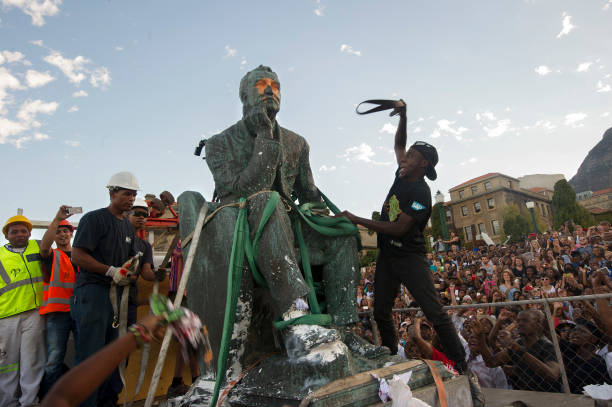Omanyano ovanhu koikundaneki yomalungula kashili paveta, Commisiner Sakaria takunghilile
Veronika Haulenga
Omanyano ovanhu koikundaneki yomalungula kashili paveta, Commisiner Sakaria takunghilile
Veronika Haulenga
Listeners:
Top listeners:
-
play_arrow
Omanyano ovanhu koikundaneki yomalungula kashili paveta, Commisiner Sakaria takunghilile Veronika Haulenga
Colonial statues in Africa have been removed, returned and torn down again – why it’s such a complex history


By Sophia Labadi, University of Kent
In 2020, the murder of George Floyd in the US served as a catalyst for the global Black Lives Matter movement. It sparked widespread protests against police brutality and systemic racism. It also ignited debates about historical symbols of oppression, such as statues of figures associated with racial injustices.
These debates presented colonial statues in Africa as having been contested and toppled for many years, ever since African states gained independence. Indeed, colonial statues were at the heart of the colonial world, symbolising its violence, white supremacy and the erasure of precolonial history. But colonial monuments in African public spaces have much more complex and often overlooked histories.
As a scholar of African heritage, I recently published a study examining colonial statues and how they have been regarded in postcolonial Africa. My historical investigation highlights three major phases.
First, in the era of independence of African states, from the 1950s to 1980, some statues were removed from public spaces, but many remained.
Second, the 1990s and 2000s were marked by the “return of empires”: statues that had been removed were put back in public spaces and new neo-colonial monuments were constructed.
Third, the renewed challenges to colonial statues from the 2010s faced some strong resistance. Understanding this history is crucial, as it exposes the challenges of truly moving beyond the colonial world and order.
Colonial statues at independence (1950s-1980)
As African countries gained independence from the 1950s to the 1980s, colonial statues faced three main fates: recycling; defacement or toppling; and on-site preservation.
Recycling involved relocating statues from former colonies to former colonial metropolises. Most went from Algeria to France and from Kenya to England. The statues of Lord Kitchener and General Gordon, for example, were sent from Khartoum in Sudan to England in 1958. The reasons for these repatriations were multiple and included the desire to keep alive memory of colonial times and to feed colonial nostalgia.
Defacing or toppling was the second phenomenon, which occurred across the continent, from Algeria to Mozambique. One instance was the defacement and toppling of the statue of Joan of Arc in Algiers in 1962. These acts of violence were necessary responses to the violence of the colonial order and represented a break from the past. They also symbolised the cleansing of public spaces, to destroy symbolically the power imbalances, racism, inequalities and urban exclusions that defined the colonial world. Some of these toppled statues were then sent back and recycled in the former metropolis.
However, across Africa, many colonial monuments remained untouched, for various reasons. Some African leaders at independence were pro-Europe, having been educated there or having worked there during colonial times. And at independence, privileged links were forged between the former colonies and the metropolises. This was the case with some former French colonies. As a result, the leaders of former French colonies did not want to change the key symbols of the colonial world.
The empires strike back (1990s-2000s)
From the 1990s, many colonial statues dismantled and hidden during the independence era were reinstalled. Aid from former imperial powers to former colonial countries is one explanation. An example is the controversial re-erection of the statue of former Belgian king and Congo “owner” Leopold II in front of the main train station in Kinshasa, capital of the Democratic Republic of Congo, in 2005. It’s easy to see why: the millions of US dollars in aid that Belgium gives the DRC every year.
The turn of the millennium also saw (neo)colonial statues deliberately erected to celebrate 19th century explorers and missionaries. In countries that were once part of the British Empire, such statues were built to attract tourists. For example, a new statue of David Livingstone was erected in 2005 for the 150th anniversary of his arrival at Mosi-oa-Tunya (Victoria Falls) in Zambia. It was paid for by airlines, travel agencies, luxury lodges, TotalEnergies and local authorities.
However, this statue of Livingstone can also be seen as an international event, linked to colonial monuments built with France’s cooperation. This is notably the case of the 2006 Savorgnan de Brazza memorial erected in Brazzaville, capital of the Republic of Congo. This project of Algeria, Congo, France and Gabon reburied the remains of the Italian-French explorer De Brazza, his wife and their children in the memorial.
The project mixed geopolitics and bilateral aid, cultural diplomacy and colonial violence. Echoing imperial rivalries, the memorial and its statue also served as distinct markers of France’s spheres of influence, and its attempt to counteract its decline in the region.
Renewed contestations (from the 2010s)
(Neo)colonial monuments were increasingly contested in the 2010s. Such protests have accelerated in recent years and have become more visible, thanks to social networks.
The most famous case is the Rhodes Must Fall movement. This led to the removal of the statue of the British colonialist Cecil John Rhodes on the campus of the University of Cape Town in South Africa in April 2015. This movement opposed neoliberal economic systems which had failed to respond to fundamental change, especially in areas such as education.
The movement quickly spread to other countries, inspiring other protests such as “#GandhiMustFall” in Ghana, Malawi and England. Statues of the Indian leader Gandhi, considered a racist, were contested. Another movement is “Faidherbe must fall”, aiming to remove the statue of the French colonial administrator Faidherbe in Saint-Louis/Ndar in Senegal and in Lille in France.
Some of these movements have drawn attention to the link between colonial or racist statues and aid. For example, the #GandhiMustFall movement prevented the construction of a Gandhi statue in Malawi in 2018. This project was linked to a US$10 million aid deal from India.
A complex issue
While acknowledging successes in removing colonial statues, it is important not to overlook the substantial support for (neo)colonial monuments all over Africa.
Such support can be explained by pressure from former colonial powers and the links of elites with these countries. Financial constraints, international aid and the potential of tourism are also factors. Then there’s the conviction that all vestiges of the past, even the most painful, must be preserved.
The statue of the French military commander Philippe Leclerc in Douala in Cameroon, for example, still stands, despite being attacked several times by Cameroonian activist André Blaise Essama.
As a result, (neo)colonial statues still have a bright future ahead of them.![]()
Sophia Labadi, Professor of Heritage, University of Kent
This article is republished from The Conversation under a Creative Commons license. Read the original article.
Written by: Contributed
aid colonial statues defacement empires Faidherbe must fall Gandhi Must Fall historical symbols independence neo-colonialism postcolonial Africa preservation Protests Recycling Rhodes Must Fall systemic racism toppling Tourism
Similar posts
Windhoek Weather
Most popular

Namdia Heist: More questions, lots of confusion

Omuhwahwameki Michael okuunganeka oshikonga shoku patitha oostola dho Rani moshilongo ashihe.

Walvis Bay woman loses over N$777.000 to a fraudster

Don’t let Pohamba’s tears over Nujoma’s death go to waste

Justice Served: Jandre Dippenaar Found Guilty of Six Murders in Swakopmund Court
Copyright 2025 Future Media (Pty) Ltd | Website by Digital Platforms
Tel: +264 83 000 1000 | Email: news@futuremedia.com.na





